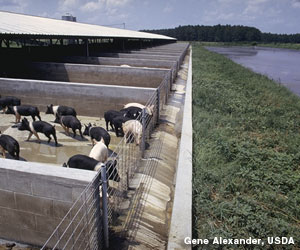Farm Size Behind Regional Differences in Hog Output
and Productivity
Nigel
Key and William
D. McBride 
In recent years, there have been substantial geographical
shifts in hog production and differences in hog
farm productivity growth rates. ERS research indicates
that changes in farm size explain much of this regional
variation.
The Heartland and Southeast regions
(see table footnotes for definitions) together account
for three-quarters of U.S. feeder pig-to-finish
hog production. Between 1992 and 1998, hog farms
in the Southeast and other regions grew at a faster
rate than farms in the Heartland. As a result, hog
production shifted from the Heartland to the Southeast
and other regions. Between 1998 and 2004, the average
size of hog farms in the Heartland doubled, while
farms in the Southeast grew at a slower rate (though
starting from a larger base). As a result, the Heartland’s
share of hog output grew 10 percentage points while
the Southeast’s share declined.
Policy changes at the State level
help explain the Southeast’s decline in output
share and farm size growth rate. Farms in North
Carolina produce, on average, over 90 percent of
hog output in the Southeast. In 1997, North Carolina
passed the Clean Water Responsibility and Environmentally
Sound Policy Act, which imposed a moratorium on
the construction or expansion of new or existing
hog operations with 250 or more head. Exceptions
included new construction using “innovative
animal waste management systems that do not employ
an anaerobic lagoon.” North Carolina extended
the moratorium several times through 2007 and passed
legislation that strictly regulates manure management
systems.
Regional changes in feed productivity
(hog output per unit of feed) display a similar
pattern to output share. From 1992 to 1998, farms
in the Southeast attained larger increases in average
feed productivity than did farms in the Heartland.
Between 1998 and 2004, this pattern reversed, with
average feed productivity in the Heartland more
than doubling.
Hog
farm size explains regional differences in
productivity growth |
| |
|
|
|
|
|
|
|
Share of feeder
pig-to-finish output |
|
|
|
Heartland
|
58 |
35 |
45 |
Southeast
|
20 |
32 |
25 |
Other regions
|
22 |
32 |
30 |
| |
Hundredweight
(cwt) gain per farm |
|
Average farm output |
|
|
|
Heartland
|
|
|
|
Southeast
|
|
|
|
Other regions
|
|
|
|
| |
|
|
Feed productivity |
|
|
|
Heartland
|
0.29 |
0.31 |
0.76 |
Southeast
|
0.28 |
0.44 |
0.63 |
Other regions
|
0.24 |
0.31 |
0.63 |
| Note:
Regions are defined by States: Heartland (IA,
IL, IN, KY, MO, and OH); Southeast (AL, AR,
GA, NC, SC, and VA); and other regions (CO,
KS, MI, MN, NE, OK, PA, SD, TN, TX, UT, and
WI). Hundredweight gain equals hundredweight
of hogs sold or removed under contract less
hundredweight of hogs purchased or placed
under contract, plus hundredweight of inventory
change each year.
Source: USDA, Economic Research Service, using
data from USDA’s 1992 Farm Costs and
Returns Survey and the 1998 and 2004 Agricultural
Resource Management Surveys. |
ERS research indicates that trends
in total farm productivity, which aggregates the
productivity of all major inputs, mirrored trends
in farm output and feed productivity. Productivity
increased more in the Southeast between 1992 and
1998 and more in the Heartland between 1998 and
2004. These regional differences in productivity
growth since 1992 are explained mostly by different
rates of growth in farm size (larger farms operate
at a more efficient scale of production) rather
than different rates of technical innovation. Consequently,
policies to regulate hog enterprise expansion, like
the North Carolina moratorium, can have an indirect,
but adverse effect on productivity growth.
|